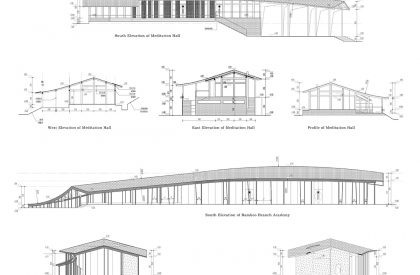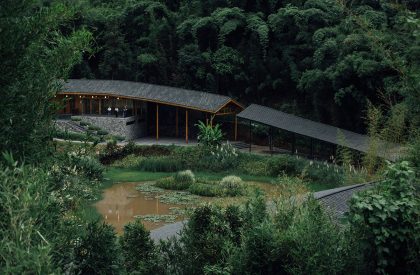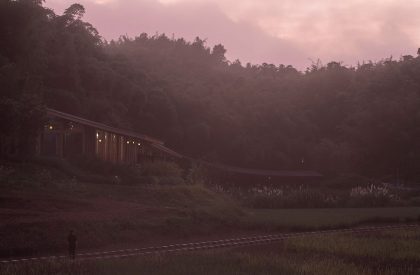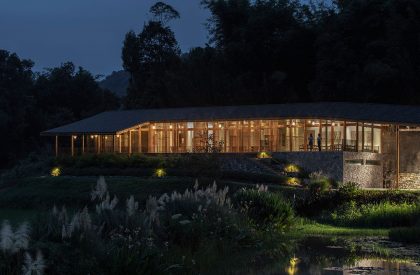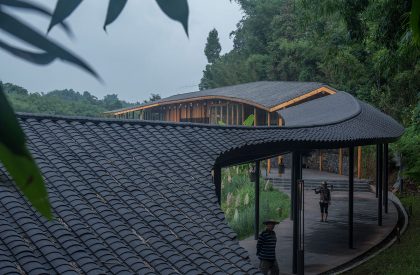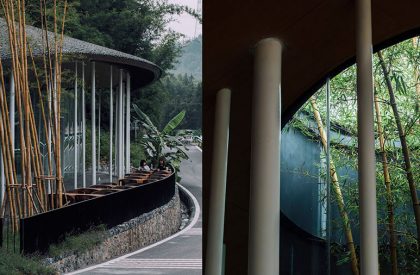Excerpt: Bamboo Branch Academy is a public-oriented space designed by the architectural firm Archemit. Its architectural purpose is to “develop the bamboo industry following local conditions, and landscape Sichuan villages with bamboo forests” and “make bamboo of Yibin an ecological gateway to introduce southern Sichuan to the world.”
Project Description
[Text as submitted by the architects] “Bamboo Branch Academy” is located in Yongjiang Village, Zhuhai Town, Changning County, Yibin, Sichuan Province, near the famous Shunan Bamboo Sea Scenic Area. The project, situated in a small village in Huangjuetan, Yongjiang Village, is surrounded by bamboo forests, paddy fields, vegetable fields, and hills. The Yujiang River is babbling in the west and the south, and Shunan Bamboo Sea in the north rolls like a large green screen.

“Bamboo Branch Academy” was developed as China implemented the “rural revitalization” strategy. Mentally, its architectural purpose is to “develop the bamboo industry in accordance with local conditions, and landscape Sichuan villages with bamboo forests” and “make bamboo of Yibin an ecological gateway to introduce southern Sichuan to the world.” Physically, its architectural purpose is to build the Music Workshop under Bamboo, Paddy Field Academy, and Guild Hall for Buddhist Meditation.

Architectural imagery
The field visit is a necessary process to transform conceptual images into impressions and abstract the impressions into the core architectural imagery. The first visit was conducted in the late winter of January 2019. We were impressed by the various images here – the bamboo-clad hills around the base, the mud walls covered with bamboo strips surrounding the dilapidated house, the grayish blue tiled roof, and the plantain trees next to the old house.

They are common in the countryside of Sichuan, and hardly can leave a deep impression. We got excited upon seeing the bamboo forest by the river before leaving. A few had sprouted, reminding us of a bamboo-themed poem written by Zhang Zhengjian. It was a breezy and sunny day to explore the bamboo forest. In ancient China, music was called “Sizhu”, and traditional Chinese musical instruments such as flute, xiao, sheng, zheng and erhu are all made of bamboo.


Zhuzhi (bamboo branch) is the name of a tune and one of the Yuefu poems. Zhuzhi is closely related to the music workshop as the folk song, and to the academy as the poem. Bamboo branches are important not only to bamboo itself, but also to traditional Chinese literature. The concrete and abstract imageries of bamboo branches coincided with the architectural purpose (music workshop, academy and meditation) and the scene that “the bamboo trees on the hills around the village were about to reach the sky with tender shoots like clusters of green clouds” greatly impressed us.

Architectural artistic conception
People in southern Sichuan live in villages built with and surrounded by bamboo traditionally, as characterized by “one house with one patch of farmland and one courtyard.” Mou Yanwu’s Written while Living near Water and Bamboo offers a prime example.

With its barrage of beautiful imagery—such as a cabin encircled by clear water, green chiffon, vibrant fish and birds, the reflection of a balustrade on the rippling water, a small writing desk, a gentle green drizzle— the poem truly portrays the project’s architectural concept. Liu Yuxi’s Bamboo Branch Song depicts an idyllic mood very similar to the scenes of interaction circulating for the architectural project of Bamboo Branch Academy.

Endowing forms with ideas, and perceiving ideas through forms
“Bamboo Branch Academy” is created by remodeling two old houses in southern Sichuan. The functions of the music workshop, academy, and meditation should be well combined to separate Bamboo Branch Academy into two parts. The idea of bamboo knots is turned into the form of the interior and exterior of the academy for meditation.

The idea of the unrivaled nature of bamboo is integrated with that of liveliness of the music workshop. The undulating grayish blue tiled roof, the embodiment of the image that the “house is surrounded,” is compatible with the “hills covered with bamboo forests” in the vicinity, and a response to the requirements of local people for “prosperity of the new and the old.”


The relocation and integration of plantain trees, bamboo groves and farm paths endow Bamboo Branch Academy with a gentle heart, which, as a new member, is once again embraced by the village!Bamboo Branch Academy is expected to shape the scenery of and add “poetic and pictorial splendor” to Yongjiang Village, Yibin.







